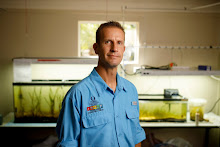After four hours sleep Sunday night and zero Monday night, at 7 pm on Tuesday I FINISHED my dissertation and sent it to my graduate committee. Then I picked up some fast food, rented Quentin Tarantino's "Planet Terror" and let my brain decompress for a while before dropping into a very deep sleep. I woke up at 1:15 pm on Wednesday and stepped outside for some fresh air. The sky was bluer, the trees greener, and the birdsongs sweeter than they had seemed to me for a long time.
Sure, I still have a few hoops to jump through (i.e. the dissertation seminar and defense on July 9th) and loose ends to tie up (i.e. getting the final three chapters published in peer-reviewed journals), but for right now I feel pretty damn good. Saturday I'll celebrate not being in my office by doing some windsurfing lessons for all the summer interns and new grad students at VIMS.
PS- For those interested, here is the abstract of the dissertation:
Community dynamics in submersed aquatic vegetation: intermediate consumers as mediators of environmental change
ABSTRACT
Natural ecosystems are strongly affected by changes in resource supply (bottom-up forces) and by changes in upper trophic levels (top-down forces). The extent to which these forces impact a system depends largely on the responses of organisms at middle trophic levels. In seagrass beds, a group of mid-level consumers known as mesograzers form a critical link in the chain of impact, connecting seagrass and epiphytic algae with predatory fishes and crustaceans. We observed dramatic fluctuations in mesograzer abundance and species composition in eelgrass (Zostera marina) beds of lower Chesapeake Bay, Virginia, and endeavored to explain the top-down and bottom-up causes and consequences of those changes through a combination of field studies and controlled experiments. A field cage experiment showed that the effects of grazing, predation and nutrient enrichment on the eelgrass community were similar in magnitude but different in nature (Chapter 1). A second experiment delved deeper into the predation dynamic by manipulating the diversity of both predators and mesograzers. Increasing predator diversity increased the strength of predation, but increasing mesograzer diversity conferred resistance to some types of predation (Chapter 2). To assess the influence of top-down and bottom-up forces in a more natural context, we analyzed the long-term changes in biotic and abiotic components of an eelgrass bed at the Goodwin Islands National Estuarine Research Reserve. We found that abiotic forces had strong effects on both consumer and resource abundance, and could therefore initiate either top-down or bottom-up control of eelgrass community structure (Chapter 3). To examine this top-down and bottom-up control in more detail we explicitly compared the ecological relationships seen in the field to those observed in mesocosm experiments. Mesocosm experiments tended to find a greater influence of top-down effects and a lesser influence of bottom-up effects, relative to field observations (Chapter 4). Finally, we took a snapshot of the eelgrass foodweb itself by examining the gut contents and stable carbon and nitrogen isotopic ratios of predators, mesograzers, and plants. We found that direct grazing on eelgrass does occur, but that microalgae and detritus provide the main trophic support for the epifaunal community (Chapter 5). Overall, our results suggest that both top-down and bottom-up forces control eelgrass community structure via mesograzers, but that top-down control in the field is more subtle and more intimately tied with bottom-up control than has been indicated by some manipulative experiments.
December 14, 2025
7 hours ago

6 comments:
Congratulations! Hope there is wind and alcohol in your weekend. The Gorge has been going off!
Sophia
It took you how long to write that?? ;) Seriously though, must be a relief to get that monkey off your back.
Hoping to get some YRS sea breeze action on Friday or Sunday. Looks like this evening might have been the ticket though. If it materializes I'll bring a couple celebratory cold ones. Just name your brand.
Sophia- I'll be in the Gorge for the second week of August.
Outdrsmn- Well, it took me five years to write the first two chapters, and 1 year to write the last three! I guess that shows that deadlines are effective. ... Doesn't look like we're going to get much breeze before sundown today.
Muy bien! Estoy felitz!
Sounds like pretty interesting stuff. It's nice to read a windsurfer/scientist's views. Ecosystems can be so vulnerable. Where I sail, the Hudson River, is the poster child for screwed up ecosystems, but even that's coming back. The sturgeon are returning.
-Ian
http://hudsonwindsurfer.blogspot.com/
Congrats dude! You're high rollin now!
Post a Comment